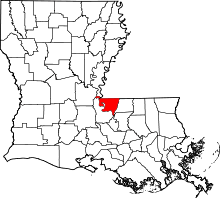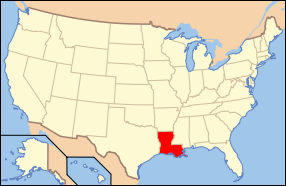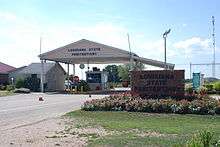West Feliciana Parish, Louisiana
| West Feliciana Parish, Louisiana | |
|---|---|
 Location in the U.S. state of Louisiana | |
 Louisiana's location in the U.S. | |
| Founded | 1824 |
| Named for | Marie Felice de Gálvez |
| Seat | St. Francisville |
| Largest town | St. Francisville |
| Area | |
| • Total | 426 sq mi (1,103 km2) |
| • Land | 403 sq mi (1,044 km2) |
| • Water | 23 sq mi (60 km2), 5.3% |
| Population | |
| • (2010) | 15,625 |
| • Density | 39/sq mi (15/km²) |
| Congressional district | 5th |
| Time zone | Central: UTC-6/-5 |
| Website |
wfparish |

West Feliciana Parish (French: Paroisse de Feliciana Ouest) is a parish located in the U.S. state of Louisiana. As of the 2010 census, the population was 15,625.[1] The parish seat is St. Francisville.[2] The parish was established in 1824.[3]
Feliciana Parish was one of two 19th-century Louisiana parishes to be divided into East and West, the other being Carroll Parish.
West Feliciana Parish is part of the Baton Rouge, Louisiana, Metropolitan Statistical Area.
The River Bend Nuclear Generating Station, operated by Entergy Nuclear, is located in West Feliciana Parish below St. Francisville. It produces approximately 10 percent of the total electric power demand in Louisiana.[4]
The Louisiana State Penitentiary is also located in the Parish, in Angola.
History

18th & 19th centuries
Following the founding of the Bayou Sara settlement by Franciscan/Capuchin monks in the late 17th century, the area was explored further by Spain, France, and Great Britain. The original settlement has been covered over by waters of the Mississippi River, which shifted course.
After 1763, when France was defeated by Britain in the Seven Years' War, it ceded this part of La Louisiane to Great Britain, which included it in its West Florida province. Spain gained control of the area in about 1780 – during the American Revolutionary War – and maintained its authority in the area for the next three decades.
In 1810, the colonists, many of whom were of British descent, rebelled against the colonial regime and established the short-lived independent Republic of West Florida. Within a few months, the United States declared the area to be part of the territory included in the Louisiana Purchase of 1803. (Today this region is called the Florida Parishes).
Feliciana Parish was established in 1810, in the Territory of Orleans, which was admitted to the Union two years later as the state of Louisiana. With continued growth of population, in 1824 Feliciana Parish was divided into the East Feliciana and West Feliciana parishes.[3]
During the American Civil War, West Feliciana Parish provided financial assistance to the families of soldiers fighting for the Confederate States of America. Wives and children of soldiers were to receive from $10 to $40 per month, depending on family size.[5]
West Feliciana & national politics
Since before the Civil War, West Feliciana had been historically Democratic in voter preference. But after passage of Federal civil rights legislation in the mid-1960s, many white conservatives in the South began to shift to the Republican Party, at least in terms of supporting Presidential candidates. In 1972, the year of Richard Nixon's re-election as President, West Feliciana was the only Louisiana parish to support the George McGovern and Sargent Shriver ticket. During the same period, most African Americans in the South began to support the national Democratic Party, which had helped their drive for civil rights.
Since 2000, white voters in the parish have supported the Republican Party candidates in Presidential elections. That year Bush-Cheney polled 2,512 votes (55 percent), compared to 2,187 (45 percent) for Democrats Al Gore and Joe Lieberman. West Feliciana voters helped to re-elect George W. Bush and Dick Cheney in 2004, with 2,932 (56 percent) to 2,214 (42 percent) over Democratic candidates John Kerry and John Edwards. Republicans John McCain and Sarah Palin won the parish in 2008, but they lost the Presidential/Vice-Presidential contest to Democrats Barack Obama and Joe Biden.
Geography
According to the U.S. Census Bureau, the parish has a total area of 426 square miles (1,100 km2), of which 403 square miles (1,040 km2) is land and 23 square miles (60 km2) (5.3%) is water.[6]
The parish is located on the Mississippi River, and is bordered by Pointe Coupee Parish to the west and East Feliciana Parish to the east. The parish is about 30 miles (48 km) north of Baton Rouge and about 60 miles (97 km) south of Natchez, Mississippi.[7]
The area—including references to the loess soil and Louisiana State Penitentiary—was used by Walker Percy as the setting for his last novel, The Thanatos Syndrome.
Major highways
Adjacent parishes and counties
- Wilkinson County, Mississippi (north)
- East Feliciana Parish (east)
- East Baton Rouge Parish (south)
- West Baton Rouge Parish (south)
- Pointe Coupee Parish (southwest)
- Avoyelles Parish (northwest)
- Concordia Parish (northwest)
National protected area
Demographics
| Historical population | |||
|---|---|---|---|
| Census | Pop. | %± | |
| 1820 | 12,732 | — | |
| 1830 | 8,629 | −32.2% | |
| 1840 | 10,910 | 26.4% | |
| 1850 | 13,245 | 21.4% | |
| 1860 | 11,671 | −11.9% | |
| 1870 | 10,499 | −10.0% | |
| 1880 | 12,809 | 22.0% | |
| 1890 | 15,062 | 17.6% | |
| 1900 | 15,994 | 6.2% | |
| 1910 | 13,449 | −15.9% | |
| 1920 | 12,303 | −8.5% | |
| 1930 | 10,924 | −11.2% | |
| 1940 | 11,720 | 7.3% | |
| 1950 | 10,169 | −13.2% | |
| 1960 | 12,395 | 21.9% | |
| 1970 | 11,376 | −8.2% | |
| 1980 | 12,186 | 7.1% | |
| 1990 | 12,915 | 6.0% | |
| 2000 | 15,111 | 17.0% | |
| 2010 | 15,625 | 3.4% | |
| Est. 2015 | 15,385 | [8] | −1.5% |
| U.S. Decennial Census[9] 1790-1960[10] 1900-1990[11] 1990-2000[12] 2010-2013[1] | |||
As of the 2010 United States Census, there were 15,625 people residing in the parish. 52.0% were White, 46.5% Black of African American, 0.2% Asian, 0.1% Native American, 0.6% of some other race and 0.6% of two or more races. 1.6% were Hispanic or Latino (of any race).
As of the census[13] of 2000, there were 15,111 people, 3,645 households, and 2,704 families residing in the parish. The population density was 37 people per square mile (14/km²). There were 4,485 housing units at an average density of 11 per square mile (4/km²). The racial makeup of the parish was 48.63% White, 50.51% Black or African American, 0.20% Native American, 0.17% Asian, 0.02% Pacific Islander, 0.03% from other races, and 0.44% from two or more races. 1.04% of the population were Hispanic or Latino of any race.
There were 3,645 households out of which 38.90% had children under the age of 18 living with them, 54.10% were married couples living together, 15.60% had a female householder with no husband present, and 25.80% were non-families. 23.10% of all households were made up of individuals and 8.20% had someone living alone who was 65 years of age or older. The average household size was 2.73 and the average family size was 3.24.
In the parish the population was spread out with 20.30% under the age of 18, 8.70% from 18 to 24, 40.00% from 25 to 44, 23.80% from 45 to 64, and 7.20% who were 65 years of age or older. The median age was 37 years. For every 100 females there were 191.10 males. For every 100 females age 18 and over, there were 223.60 males.
The median income for a household in the parish was $39,667, and the median income for a family was $47,239. Males had a median income of $35,046 versus $21,922 for females. The per capita income for the parish was $16,201. About 15.00% of families and 19.90% of the population were below the poverty line, including 25.30% of those under age 18 and 23.40% of those age 65 or over.
In January 2007 the State of Louisiana estimated that 15,318 people lived in the parish, with 5,000 of them being prisoners at Louisiana State Penitentiary (Angola).[7]
Government and infrastructure
Louisiana State Penitentiary of the Louisiana Department of Public Safety and Corrections is located in unincorporated West Feliciana Parish.[14]
Education
West Feliciana Parish Public Schools serves the parish. All residents are zoned to Bains Lower Elementary School, Bains Elementary School, West Feliciana Middle School, and West Feliciana High School.[15] Tunica Elementary School, a parish elementary school, was closed after the parish school board voted to close the school in May 2011.[16]
Some students in the parish attend Wilkinson County Christian Academy in Wilkinson County, Mississippi.[17]
The West Feliciana Parish Library is located in St. Francisville.[18] The library, previously a part of the Audubon Regional Library System, became independent in January 2004.[19]
The parish's proximity to Baton Rouge offers access to Louisiana State University, Southern University, and Baton Rouge Community College.[7]
News media
Founded in 1892, the St. Francisville Democrat was the parish's local newspaper and served as the official journal for the parish's governmental bodies. The paper, founded by W. W. Leake and his wife May, was originally called "The True Democrat." After Leake's death, May Leake married Elrie Robinson and they continued publication of the newspaper.[20] After May's death in the 1920s, Robinson remarried. The paper was later published by Elrie's son James M. Robinson, who sold it to Marilyn and David Goff in the 1970s. The newspaper was bought by Louisiana Suburban Press in 1979. Louisiana Suburban Press is part of Louisiana State Newspapers, owned by B.I Moody.
On October 1, 2014, the Democrat was sold by Louisiana State Newspapers to Capital City Press, Inc., owner of The Advocate (a major newspaper of Baton Rouge) and of other newspapers in the region. The last editor of the St. Francisville Democrat was M.W. Willis, widow of Hamilton Barrow Willis of (Avalon and Tanglewild plantations in) West Feliciana.
The Democrat ceased to be published as such; the news of the area is part of a "zoned" (localized) special section called The Advocate Extra - a section combining news from St. Helena, East Feliciana, and West Feliciana Parishes that debuted on October 9, 2014.
The Feliciana Explorer is an independent publication mailed to residents of East and West Feliciana. It is owned and published by Daniel Duggan, who also owns the Zachary Post.
Founded in 1976, The Angolite is a news magazine created and published at the Louisiana State Penitentiary.[21] Each year, it publishes six issues.[22]
Communities
Town
Unincorporated communities
- Louisiana State Penitentiary (Angola)
- Bains
- Tunica
- Wakefield
Notable people
- General Robert Hilliard Barrow (February 5, 1922 – October 30, 2008) was the 27th Commandant of the United States Marine Corps (USMC) from 1979 to 1983. Barrow served for 41 years, including overseas command duty in three wars. He was awarded the Navy Cross and the Distinguished Service Cross. He grew up on his family’s Rosale Plantation in West Feliciana Parish. He is interred at the Grace Episcopal Church Cemetery in St. Francisville.
- Rob Couhig, New Orleans businessman and politician, was reared in West Feliciana Parish.
- Cheston Folkes, Louisiana state representative from West Feliciana Parish, 1908-1920, 1924-1932, and 1936-1940
- Warren Davis Folkes, member of both houses of the Louisiana legislature from West Feliciana Parish from 1944 to 1976
- Norman E. "Pete" Heine, the West Feliciana parish administrator, after having served for twenty-three years as the mayor of Baker in East Baton Rouge Parish
- Samuel Lawrason, St. Francisville attorney and state senator who authored the Lawrason Act of 1898.[23]
- Sam A. LeBlanc, III, lawyer and politician; half-brother of Rob Couhig, retired to St. Francisville c. 2006
- Tom McVea, state representative.
- L. Christian Mixon, American film and television actor, reared near St. Francisville.
- John Richard Rarick, attorney and U.S. Representative from St. Francisville.
- Major Thibaut, state representative since 2008 for District 18, which includes West Feliciana Parish; businessman from Pointe Coupee Parish
- E. M. Toler, state senator from East and West Feliciana parishes from 1944 to 1954; physician from Clinton, Louisiana
See also
- Louisiana State Penitentiary
- National Register of Historic Places listings in West Feliciana Parish, Louisiana
- River Bend Nuclear Generating Station
References
- 1 2 "State & County QuickFacts". United States Census Bureau. Retrieved August 18, 2013.
- ↑ "Find a County". National Association of Counties. Retrieved 2011-06-07.
- 1 2 "West Feliciana Parish". Center for Cultural and Eco-Tourism. Retrieved September 5, 2014.
- ↑ www.entergy-nuclear.com, accessed 27 October 2015.
- ↑ John D. Winters, The Civil War in Louisiana, Baton Rouge: Louisiana State University Press, 1963, ISBN 0-8071-0834-0, p. 74
- ↑ "2010 Census Gazetteer Files". United States Census Bureau. August 22, 2012. Retrieved September 2, 2014.
- 1 2 3 "West Feliciana Parish School System Profile." (Archive) West Feliciana Parish School System. 1. Retrieved on February 18, 2012.
- ↑ "County Totals Dataset: Population, Population Change and Estimated Components of Population Change: April 1, 2010 to July 1, 2015". Retrieved July 2, 2016.
- ↑ "U.S. Decennial Census". United States Census Bureau. Retrieved September 2, 2014.
- ↑ "Historical Census Browser". University of Virginia Library. Retrieved September 2, 2014.
- ↑ "Population of Counties by Decennial Census: 1900 to 1990". United States Census Bureau. Retrieved September 2, 2014.
- ↑ "Census 2000 PHC-T-4. Ranking Tables for Counties: 1990 and 2000" (PDF). United States Census Bureau. Retrieved September 2, 2014.
- ↑ "American FactFinder". United States Census Bureau. Retrieved 2008-01-31.
- ↑ "Louisiana State Penitentiary." Louisiana Department of Public Safety and Corrections. Retrieved on August 24, 2010.
- ↑ "Schools." West Feliciana Parish Public Schools. Retrieved on February 18, 2012.
- ↑ Rivas, Brittany. "West Feliciana board closes elementary school." WBRZ. May 18, 2007. Retrieved on February 18, 2012.
- ↑ "About the School" (Archive). Wilkinson County Christian Academy. Retrieved on April 15, 2015.
- ↑ "Directory." West Feliciana Parish Library. Retrieved on September 29, 2010.
- ↑ "About Us." West Feliciana Parish Library. Retrieved on September 29, 2010.
- ↑ Butler, Anne (September 23, 2014). "Farewell to St. Francisville's True Democrat and Welcome to The Advocate". Friends in St. Francisville, La. Retrieved 1 December 2014.
- ↑ "Rehabilitative Services / Work Programs." Louisiana State Penitentiary. Retrieved on August 29, 2010.
- ↑ ""Time in Prison", Louisiana Department of Public Safety & Corrections. 34/40. Retrieved on September 23, 2010.
- ↑ "Lawrason, Samuel McCutcheon". Louisiana Historical Association, A Dictionary of Louisiana Biography (lahistory.com). Retrieved December 27, 2010.
External links
| Wikimedia Commons has media related to West Feliciana Parish, Louisiana. |
- St. Francisville and West Feliciana Parish Website
- St. Francisville and West Feliciana Tourism Commission
- Explore the History and Culture of Southeastern Louisiana, a National Park Service Discover Our Shared Heritage Travel Itinerary
- West Feliciana Parish Sheriff's Office
 |
Avoyelles Parish and Concordia Parish | Wilkinson County, Mississippi |  | |
| |
East Feliciana Parish | |||
| ||||
| | ||||
| Pointe Coupee Parish | West Baton Rouge Parish and East Baton Rouge Parish |
Coordinates: 30°52′N 91°25′W / 30.87°N 91.42°W